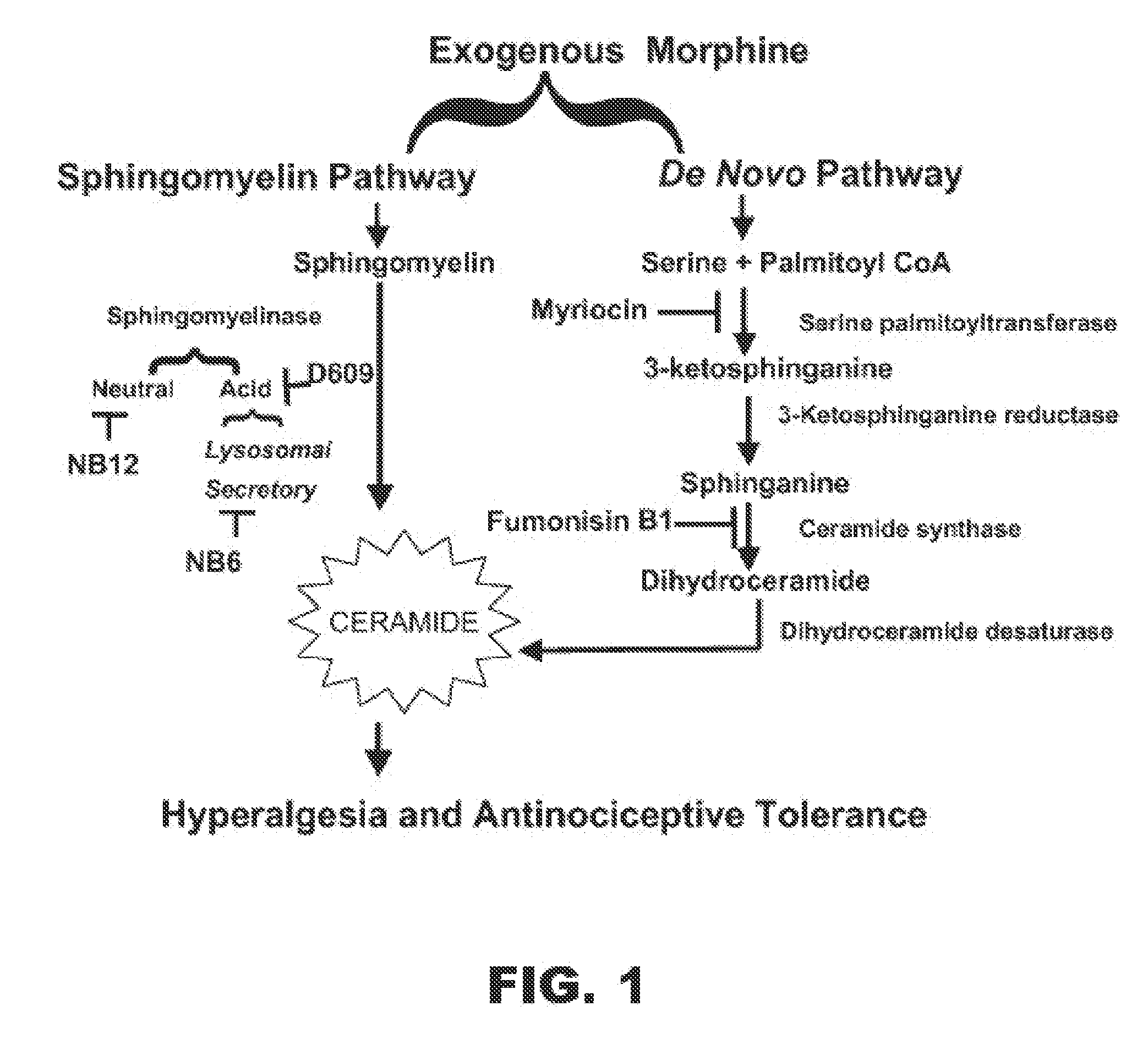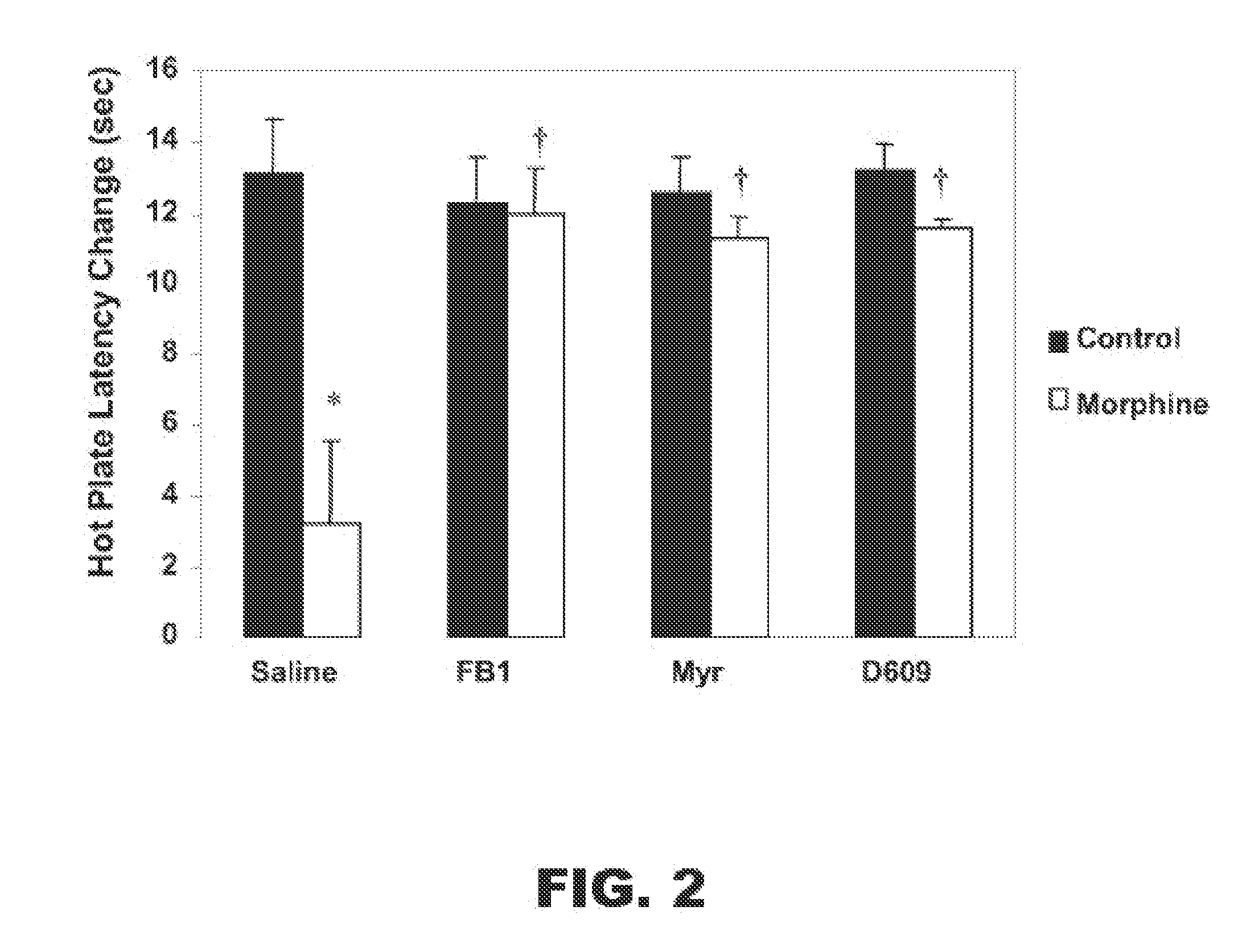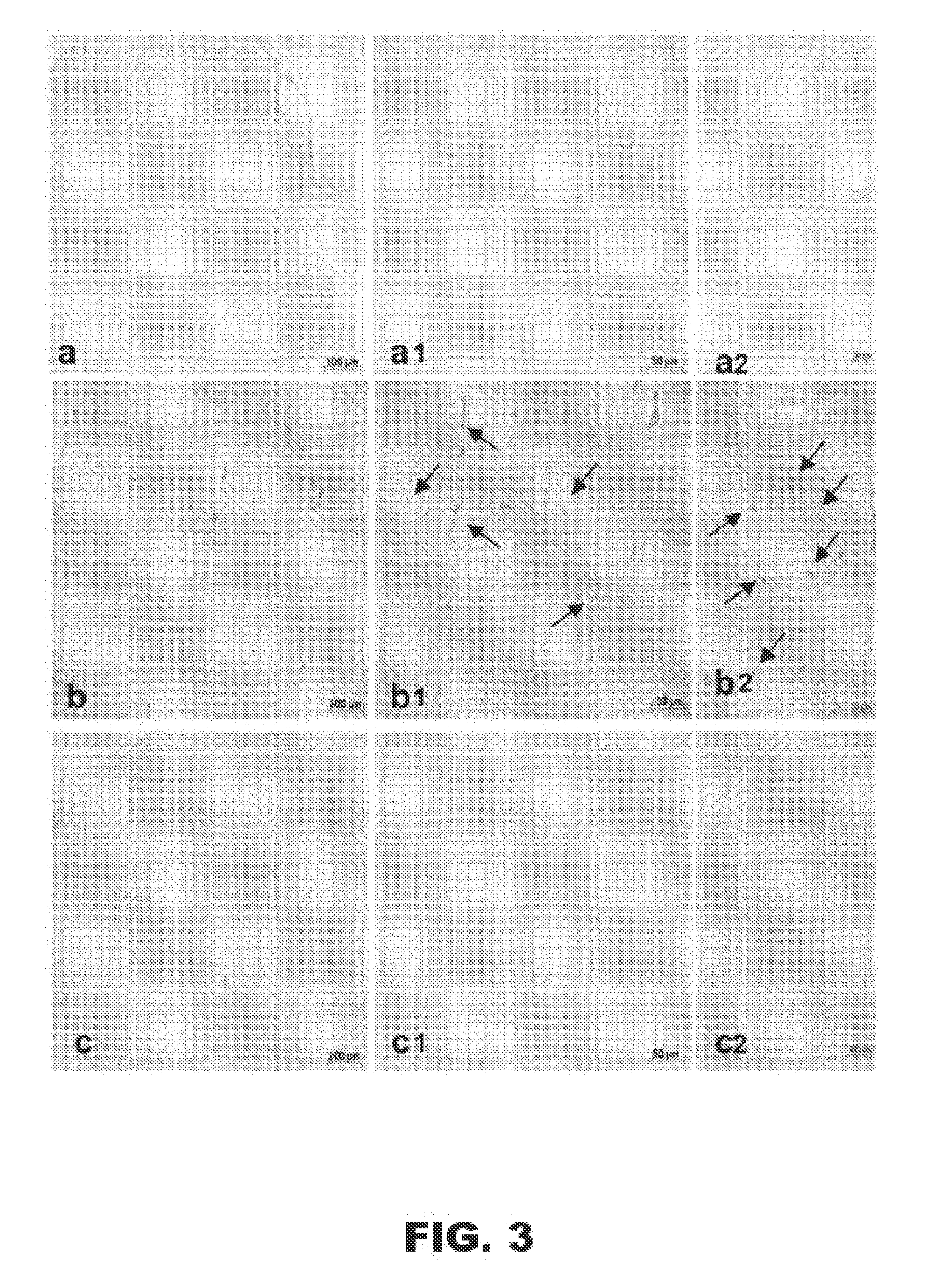[0014]In various other embodiments, the present invention includes a method for reducing, preventing or delaying the development of tolerance to, and / or physical dependence on, an opioid drug that targets an opioid receptor. The method includes administering to a subject in need thereof, an analgesic amount of the opioid drug and a therapeutically effective amount of an agent that inhibits ceramide biosynthesis inhibitor. The ceramide synthesis inhibitor may be administered within a therapeutically effective time with respect to administering the opioid drug. In various aspects of this embodiment, the ceramide synthesis inhibitor may be administered prior to administration of the opioid drug, for example about 15 minutes, about 2 hours, or about 24 hours prior to administration of the opioid drug; the ceramide synthesis inhibitor may be administered at substantially the same time as the opioid drug; or the ceramide synthesis inhibitor may be administered after administration of the opioid drug, for example about 15 minutes, about 2 hours, or about 24 hours after administration of the opioid drug. The opioid drug may be any opioid drug and, in particular, one that targets one or more of μ-opioid receptors, δ-opioid receptors or κ-opioid receptors. In various embodiments, the opioid drug may be morphine. The agent that inhibits ceramide biosynthesis may be an inhibitor of any one or more ceramide biosynthetic enzymes in which the ceramide biosynthetic enzyme may be a sphingomyelinase, a serine palmitoyltransferase, a 3-ketosphinganine reductase, a ceramide synthase or a dihydroceramide desaturase. In particular, the ceramide biosynthesis inhibitor may be Fumonisin B1 (FB1), tyclodecan-9-xanthogenate (D609), myriocin or any combination thereof.
[0015]The present invention also includes, in various embodiments, a method of screening for an agent that reduces, prevents or delays the development of tolerance to, and / or physical dependence on, an opioid drug that targets an opioid receptor. The method includes (a) contacting a cell comprising the opioid receptor, with an opioid drug; (b) contacting the cell with a test agent; (c) determining whether the test agent inhibits biosynthesis of ceramide in the presence of the opioid drug and / or reduces or prevents an increase in ceramide elicited by the opioid drug; and (d) selecting the test agent as an agent that may reduce, prevent or delay the development of tolerance to and / or physical dependence on the opioid drug if the test agent inhibits biosynthesis of ceramide and / or reduces or prevents an increase in ceramide levels elicited by the opioid drug. The opioid drug may any opioid drug and, in particular, one that targets one or more of μ-opioid receptors, δ-opioid receptors or κ-opioid receptors. In various embodiments, the opioid drug may be morphine. The agent that inhibits ceramide biosynthesis may be an inhibitor of any one or more ceramide biosynthetic enzymes in which the ceramide biosynthetic enzyme may be a sphingomyelinase, a serine palmitoyltransferase, a 3-ketosphinganine reductase, a ceramide synthase or a dihydroceramide desaturase. Both in vitro and in vivo screening methods are within the scope of the present invention.
[0016]In various other embodiments, the present invention also includes a method for treating a biological condition associated with ceramide biosynthesis accompanying administration of an opioid in a subject. The method includes administering to a subject receiving administration of the opioid drug and having the biological condition, a therapeutically effective amount of an agent that inhibits ceramide biosynthesis. In various embodiments, the biological condition may be opioid tolerance, nitroxidative stress or neuroimmune activation. The ceramide synthesis inhibitor may be administered within a therapeutically effective time with respect to administering the opioid drug. In various aspects of this embodiment, the ceramide synthesis inhibitor may be administered prior to administration of the opioid drug, for example about 15 minutes, about 2 hours, or about 24 hours prior to administration of the opioid drug; the ceramide synthesis inhibitor may be administered at substantially the same time as the opioid drug; or the ceramide synthesis inhibitor may be administered after administration of the opioid drug, for example about 15 minutes, about 2 hours, or about 2.4 hours after administration of the opioid drug. In various aspects of this embodiment, the opioid drug may any opioid drug and, in particular, one that targets one or more of μ-opioid receptors, δ-opioid receptors or κ-opioid receptors. In various embodiments, the opioid drug may be morphine. In various embodiments, the agent that inhibits ceramide biosynthesis may be an inhibitor of any one or more ceramide biosynthetic enzymes in which the ceramide biosynthetic enzyme may be a sphingomyelinase, a serine palmitoyltransferase, a 3-ketosphinganine reductase, a ceramide synthase or a dihydroceramide desaturase. In particular, the ceramide biosynthesis inhibitor may be Fumonisin B1 (FB1), tyclodecan-9-xanthogenate (D609), myriocin or any combination thereof.
[0017]The present invention also includes, in various embodiments, a dsRNA for inhibiting ceramide biosynthesis in a cell. The dsRNA includes a sense strand and an antisense strand in which the sense strand is substantially complementary to the antisense strand. Further, the antisense strand includes a region of complementarity having a sequence substantially complementary to a target sequence of an RNA encoding a ceramide biosynthesis enzyme. The target sequence may be not more than about 30 contiguous nucleotides in length. Upon contact with a cell comprising the target sequence, the dsRNA inhibits ceramide biosynthesis. In various embodiments, the enzyme encoded by the RNA containing the target sequence, may be a sphingomyelinase, a serine palmitoyltransferase, a 3-ketosphinganine reductase, a ceramide synthase or a dihydroceramide desaturase. In various embodiments, the antisense strand may include a region of complementarity having a sequence substantially complementary to a target sequence of not more than about 30 contiguous and, in particular, from about 19 to about 21 contiguous nucleotides of a sequence encoding SEQ ID NO: 1, SEQ ID NO: 3, SEQ ID NO: 5, SEQ ID NO: 7, SEQ ID NO: 9, SEQ ID NO: 11, SEQ ID NO: 13, SEQ ID NO: 15, SEQ ID NO: 17, SEQ ID NO: 19, SEQ ID NO: 21, SEQ ID NO: 23, SEQ ID NO: 25, SEQ ID NO: 27, SEQ ID NO: 29, SEQ ID NO: 31, SEQ ID NO: 33 or SEQ ID NO: 35. In various embodiments, the antisense strand may include a region of complementarity having a sequence substantially complementary to a target sequence of not more than about 30 contiguous nucleotides and, in particular, from about 119 to about 21 contiguous nucleotides of SEQ ID NO: 2, SEQ ID NO: 4, SEQ ID NO: 6, SEQ ID NO: 8, SEQ ID NO: 10, SEQ ID NO: 12, SEQ ID NO: 14, SEQ ID NO: 16, SEQ ID NO: 18, SEQ ID NO: 20, SEQ ID NO: 22, SEQ ID NO: 24, SEQ ID NO: 26, SEQ ID NO: 28, SEQ ID NO: 30, SEQ ID NO: 32, SEQ ID NO: 34 or SEQ ID NO: 36.
[0018]In still other embodiments, the present invention includes a vector for expressing shRNA for inhibiting ceramide biosynthesis in a cell. The vector includes a sense strand, a hairpin linker, and an antisense strand in which the sense strand is substantially complementary to the antisense strand. Further, the sense strand includes a region of complementarity having a sequence substantially complementary to a target sequence of an RNA encoding a ceramide biosynthesis enzyme. The target sequence may be not more than about 30 contiguous nucleotides in length. Upon contact with a cell comprising the target sequence, the shRNA inhibits ceramide biosynthesis. In various embodiments, the enzyme encoded by the RNA containing the target sequence, may be a sphingomyelinase, a serine palmitoyltransferase, a 3-ketosphinganine reductase, a ceramide synthase or a dihydroceramide desaturase. In various embodiments, the sense strand may include a region of complementarity having a sequence substantially complementary to a target sequence of not more than about 30 contiguous and, in particular, from about 19 to about 2.1 contiguous nucleotides of a sequence encoding SEQ ID NO: 1, SEQ ID NO: 3, SEQ ID NO: 5, SEQ ID NO: 7, SEQ ID NO: 9, SEQ ID NO: 11, SEQ ID NO: 13, SEQ ID NO: 15, SEQ ID NO: 17, SEQ ID NO: 19, SEQ ID NO: 21, SEQ ID NO: 23, SEQ ID NO: 25, SEQ ID NO: 27, SEQ ID NO: 29, SEQ ID NO: 31, SEQ ID NO: 33 or SEQ ID NO: 35. In various embodiments, the sense strand may include a region of complementarity having a sequence substantially complementary to a target sequence of not more than about 30 contiguous nucleotides and, in particular, from about 19 to about 21 contiguous nucleotides of SEQ ID NO: 2, SEQ ID NO: 4, SEQ ID NO: 6, SEQ ID NO: 8, SEQ ID NO: 10, SEQ ID NO: 12, SEQ ID NO: 14, SEQ ID NO: 16, SEQ ID NO: 18, SEQ ID NO: 20, SEQ ID NO: 22, SEQ ID NO: 24, SEQ ID NO: 26, SEQ ID NO: 28, SEQ ID NO: 30, SEQ ID NO: 32, SEQ ID NO: 34 or SEQ ID NO: 36.
[0019]The present invention also includes, in various embodiments, a pharmaceutical composition tier inhibiting ceramide biosynthesis in a cell in which the pharmaceutical composition includes a dsRNA that inhibits ceramide biosynthesis and a pharmaceutically acceptable carrier. The dsRNA includes a sense strand and an antisense strand in which the sense strand is substantially complementary to the antisense strand. Further, the antisense strand includes a region of complementarily having a sequence substantially complementary to a target sequence of an RNA encoding a ceramide biosynthesis enzyme. The target sequence may be not more than about 30 contiguous nucleotides in length. Upon contact with a cell comprising the target sequence, the dsRNA inhibits ceramide biosynthesis. In various embodiments, the enzyme encoded by the RNA containing the target sequence, may be a sphingomyelinase, a serine palmitoyltransferase, a 3-ketosphinganine reductase, a ceramide synthase or a dihydroceramide desaturase. In various embodiments, the antisense strand may include a region of complementarity having a sequence substantially complementary to a target sequence of not more than about 30 contiguous and, in particular, from about 19 to about 2.1 contiguous nucleotides of a sequence encoding SEQ ID NO: 1, SEQ ID NO: 3, SEQ ID NO: 5, SEQ ID NO: 7, SEQ ID NO: 9, SEQ ID NO: 11, SEQ ID NO: 13, SEQ ID NO: 15, SEQ ID NO: 17, SEQ ID NO: 19, SEQ ID NO: 21, SEQ ID NO: 23, SEQ ID NO: 25, SEQ ID NO: 27, SEQ ID NO: 29, SEQ ID NO: 31, SEQ ID NO: 33 or SEQ ID NO: 35. In various embodiments, the antisense strand may include a region of complementarity having a sequence substantially complementary to a target sequence of not more than about 30 contiguous nucleotides and, in particular, from about 19 to about 21 contiguous nucleotides of SEQ ID NO: 2, SEQ ID NO: 4, SEQ ID NO: 6, SEQ ID NO: 8, SEQ ID NO: 10, SEQ ID NO: 12, SEQ ID NO: 14, SEQ ID NO: 16, SEQ ID NO: 18, SEQ ID NO: 20, SEQ ID NO: 22, SEQ ID NO: 24, SEQ ID NO: 26, SEQ ID NO: 28, SEQ ID NO: 30, SEQ ID NO: 32, SEQ ID NO: 34 or SEQ ID NO: 36.
 Login to View More
Login to View More 


